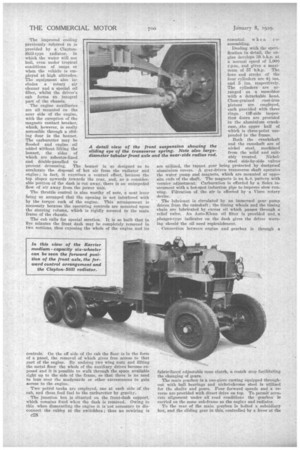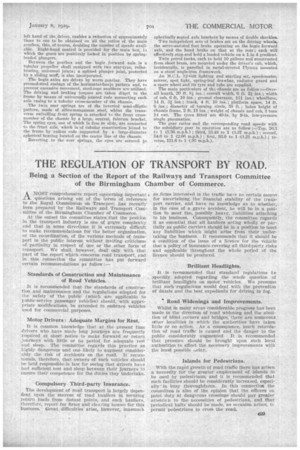A NEW RIGID SIX-WEELER
Page 13

Page 14

Page 15

If you've noticed an error in this article please click here to report it so we can fix it.
MEDIUM CAPACITY.
THEpopularity of the British-built rigid-frame six-wheeler is rapidly increasing, and it is being realized throughout t h transport world that this type of vehicle is beginning to prove a most important factor in permitting transport with equal facility on roads or across country, So much so is this the case that the overseas demand for goodstype multi-wheelers in particular is exceedingly brisk, and this quite apart from the growing employment of both goods and passenger six-wheelers at home.
In cross-country work in undeveloped areas and as feeders to existing railheads the six-wheeler is proving almost an ideal machine and, in fact, wherever atrocious ground conditions are encountered during the ordinary day's work, it provides the fastest and most reliable means for transport. The increasing demand is being recognized by prominent makers and, in this connection, a new medium-capacity goods model, known as the W06/B, has recently been brought out by Karrier Motors, Ltd., Karrier Works, Huddersfield, which has in hand a large order for these machines for the Indian Government. As the chassis embodies some particularly interesting points we will describe it in detail.
The chassis is a development of the standard WOO model which, for several years past, has been giving satisfaction to Government Departments and leading transport concerns both at home and abroad. This model carries a net load of 3 tons on roads and 2 tons across country. It incorporates a 30-40 li.p. engine, has a wheelbase of 12 ft. 6 ins., and is equipped with 36-in. by 6-in. pneumatic tyres, the driver being carried in the usual position behind the engine. As an alternative, another model, known as the W06/A, has the driver positioned alongside the engine. This latter model was favoured by the Indian Government, which already has in actual SCrviee a large number of this particular type. Following a recently completed order for 66 of this forward-control chassis, a repeat order was placed for a further batch of six-wheelers, but, in this instance, of the new W06/B type, with which we are now dealing.
The main alterations in this chassis are the employment of a larger engine, an imProved cooling system, and a longer wheelbase, this 'enabling a larger body to be mounted with the minimum overhang, which fact allows the vehicle to extract itself from ditches, etc., without fouling the rear of the body.
Perhaps the most important feature of the design, however, is the transverse swivelling-type front springing, which gives a freedom of movement to the front axle. This, together with the excellent drive afforded by the bogie axles, enables the vehicle to negotiate the most difficult country. This system of springing allows a difference of 22 ins.
between one front wheel and the other without causing any frame racking, necessitating, of course, noticeably high mudguards. The front axle is situated slightly forward of the radiator in order to obviate the employmeot of wheel arches and the attendant ironwork, which would prevent proper accessibility to the engine. Although this has increased the wheelbase, the turning circle of the complete chassis is affected but little.
The maximum depth of the frame is now 8 ins., which is considerably more than that employed before.
The improved cooling previously referred to is provided by a ClaytonStill-type radiator, in which the water will not boil, even under tropical. conditions of usage or when the vehicle is employed at high altitudes. The equipment also includes a rotary air cleaner and a special oil filter, whilst thc driver's cab forms an integral part of the chassis.
The engine auxiliaries are all mounted on the near side of the engine, with the exception of the magneto contact breaker, which, however, is easily accessible through a sliding door in the bonnet. The carburetter may be flooded and engine oil added without lifting the bonnet, the sides of which are asbestos-lined and do-uble-panelled to prevent drumming. The bonnet is so designed as to accelerate the disposal of hot air from the radiator and engine; in fact, it exercises a venturi effect, because the top slopes upwards towards the rear, and, as a considerable portion of the dash is cut away, there is an unimpeded flow of air away from the power unit.
The throttle control is also worthy of note, a neat lever being so arranged that the opening is not interfered with by the torque rock of the engine. This arrtthgement is necessary because the operating controls are mounted upon' the steering column, which is rigidly secured to the main frame of the chassis.
The cab calls for special mention. It is so built that in five minutes the front dash may be completely removed in two sections, thus exposing the whole of the engine and its
controls. On the off side of the cab thc floor is in the form of a panel, the removal of which gives free access to that part of the engine. By undoing two wing nuts and lifting the metal floor the whole of the auxiliary drives become exposed and it is possible to walk through the space available right up to the side of the frame, so that there is no need to lean over the mudguards or other excrescences to gain access to the engine.
Two petrol tanks are employed, one at each side of the cab, and these feed fuel to the carburetter by gravity.
The junction box is situated on the front-dash support, which remains fixed when thc dash is removed. Owing to this when dismantling the engine it is not necessary to disconnect the cables at the switchbox; thus no -rewiring is
c28 essential when r 0 assembling.
Dealing with the specification in detail, the engine develops 28 b.h.p. at a normal speed of 1,000 r.p.m. and gives a maximom of .57 b.h.p. The bore and stroke of the four cylinders are 4-i ins. and 5 ins. respectively. The cylinders pre arranged as a monottloe with a detachable head.
Close-grained cast-irou pistons are employed, each provided with three rings. Off-side inspee• tion doors are provided in the aluminium crankcase, the upper half of which is three-point suspended in the frame.
Both the crankshaft and the camshaft are of nickel steel, machined from the solid and suitably treated. Nickel
. steel side-by-side valves are utilized, the tappet gear being protected by dustproof aluminium covers. A gear-driven transverse shaft operates the water pump and magneto, which are mounted at opposite ends of the shaft. The magneto is an h.-t, pattern with vernier adjustment: Carburation is effected by a Soles instrument with a hot-spot induction pipe to improve slow running. Filtration of the air is effected by a Viseo rotary device.
-The lubricant is circulated by an immersed gear pump driven from the camshaft ; the timing wheels and the timing chain are lubricated by excess oil which passes through a relief valve. An Auto-Klean oil filter is provided and, a plunger-type indicator on the dash gives the driver warning should the oil need replenishment.
Connection between engine and gearbox is through a
fabric-faced adjustable cone dutch, a clutch stop facilitating the changing of gears.
The main gearbox is a one-piece casting equipped throughout with ball .bearings and nickel-chrome steel is utilized for the shafts and gears. Four forward speeds and n reverse are provided with direct drive on top. To permit accurate alignment under all road conditions the gearbox is carried on the same sub-frame as the engine and radiator.
To the rear of the main gearbox is bolted a subsidiary box, and the sliding gear in this, controlled by a lever at the left hand of the driver, enables a reduction of approximately three to one to be obtained on all the ratios of the main gearbox, this, of course, doubling the niimber of speeds available. Right-hand control is provided for the main box, i:i which the gears are positively locked in position by springloaded plungers.
Between the gearbox and the bogie forward axle is a tubular propeller shaft equipped with two star-type, rollerbearing, universal joints; a spline(' plunger joint, protected by a sliding muff, is also incorporated.
The bogie axles are driven by worm gearing. They have pressed-steel casings of the horizontal-banjo pattern and, to prevent excessive movement, steel-rope snubbers arc utilized. The driving and braking torques are taken direct to the frame by means of universally jointed rods connecting each axle casing to a tubular cross-member of the chassis.
The twin rear springs are of the inverted semi-elliptic pattern, made of silico-manganese steel, whilst the transverse swivelling front spring is attached to the front crossmember of the chassis by a large, central, fulcrum bracket. The spring eyes one of which is free to slide, are connected to the front axle, which is of tubular construction joined to the frame by radius 'rods supported by a large-diameter spherical bearing located on the centre line of the chassis.
Reverting to the rear springs, the eyes are secured to spherically seated axle brackets by means of double shackles.
Two independent sets of brakes act on the driving wheels, the servo-assisted foot brake operating on the bogie forward axle, and the hand brake on that at the rear ; each will effectively stop and hold a loaded vehicle on a 1 in 4 gradient.
Twin petrol tanks, each to hold 10 gallons and constructed from sheet brass, are mounted under the driver's cab, which, incidentally, is panelled in metal-covered Plymax mounted on a stout angle-iron framework.
An M.C.L. 12-volt lighting and starting set, speedometer, mirror, spot. light, spring-leaf drawbar, radiator guard and a spare wheel and its tyre and tube are supplied.
The main particulars of thz, chassis are as follow :—Overall length, 20 ft. 81 ins.; overall width, 6 ft. 21 ins.; width of cab, 6 ft. 10 ins. ; ground clearance, 11/ ins.; wheelbase, 14 ft. 31 ins. ; track, 4 ft. 10 ins.; platform space, 14 ft. 6 ins.; diameter of turning circle, 58 ft.; laden height of chassis frame, 2 ft. 11 ins.; weight of chassis and cab, 3 tons 14 cwt. The tyres fitted are 40-in. by 9-in, low-pressure single pneumatics.
The gear ratios and the corresponding road speeds with the subsidiary gear in operation are as follow :—Top, 20.3 to 1 (5.56 m.p.h.) ; third, 33.48 to 1 (2.37 m.p.h.) ; second, :54.6 to 1 (2.06 ; first,, 03.0 to 1 -(1.21 mph,) ; reverse, 121.6 to 1 (.03 m.p.h.).




































